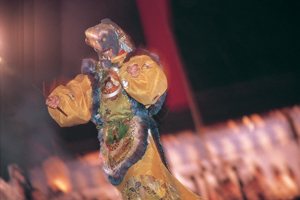Dances in the Dark
Back to Contents of Issue: December 2003
|
|
|
|
by Michael E. Stanley |
|
|
In the year 1135, starvation stalked Japan. Unseasonably heavy rain over several consecutive years had drowned the rice crops and caused an increasingly severe cycle of chronic famine.
The chief advisor to the Imperial throne, Fujiwara no Tadamichi, suggested seeking divine intervention from the water god, Ame no Oshi-kumone no Mikoto. This particular divinity happened to be the offspring of a pair of the Fujiwara clan's tutelary deities. The water god's residence at Wakamiya Shrine is only 50 paces south of the clan's main shrine of Kasuga Taisha on the slopes of Mount Mikasa, which rises above the east side of the city of Nara.
The Emperor's chief advisor had no apparent qualms about getting his ducks all in a row; conflict-of-interest legislation had yet to manifest.
Fujiwara's plan was accepted. The clan's shrine complex became the site of a great government-sponsored matsuri. (This word is usually translated as "festival," although the truer meaning in this case can be seen in the related verb matsuru, which means "to enshrine, to deify, to worship.")
Evidently the plan worked. The rains subsided and Fujiwara's standing rose even higher.
To maintain the nation's good relationship with the water deity, what is now called the On-Matsuri has been held every year since the first one in 1135. Fujiwara's machinations are now part of Japan's storied past. What remains is a stunning and unique combination of living art and ancient ceremony.
The On-Matsuri begins each October with a series of purification rituals that reach their climax on the 16th and 17th of December, when the shintai (god body) is removed from its home shrine in Wakamiya and transported in the middle of the night via a procession lighted only by two huge smoldering torches. These are dragged on the ground, leaving a glowing trail of embers that leads to a temporary shrine built of wood, earth and bamboo in the style of the ancients.
The god is installed in the shrine and is presented with rich offerings of food and sake. Late in the afternoon of December 17, the main portion of the matsuri begins on a square earthen platform raised before the temporary shrine.
This climax has earned the On-Matsuri its national status as an "Important Intangible Folk-Cultural Property." A series of dances are performed to entertain and thank the water god. Some date back to Japan's earliest eras, while others are from sources along the Silk Road and nations flanking the Mekong.
Included are the famous classical Bugaku court dances, with costumes that call to mind the cultures of continental East Asia, the Azuma-asobi, Yamato-mai and the Seino dance, which is performed by ghostlike masked dancers in white. The On-Matsuri is the only time and place at which these dances can be seen as they were originally performed -- outdoors on an earthen platform with a wood fire at each corner. The dances are timed to finish at midnight, when all lights are extinguished and Ame no Oshikumone no Mikoto is returned to his residence in another procession.
The On-Matsuri is in no way an obscure event, but it has not become a great tourist draw like the Gion and Jidai festivals of Kyoto. Despite the best efforts of the Nara tourism officials and the addition of modern lighting, the On-Matsuri does not draw crowds of thousands. Like much of Nara itself, it remains accessible on a smaller scale -- allowing a large part of its true meaning to emerge. @
|
|
Note: The function "email this page" is currently not supported for this page.


 THIS NIGHT IS AN ancient one. It has slipped through centuries and appears before me in the chill of winter here in Nara.
THIS NIGHT IS AN ancient one. It has slipped through centuries and appears before me in the chill of winter here in Nara.



